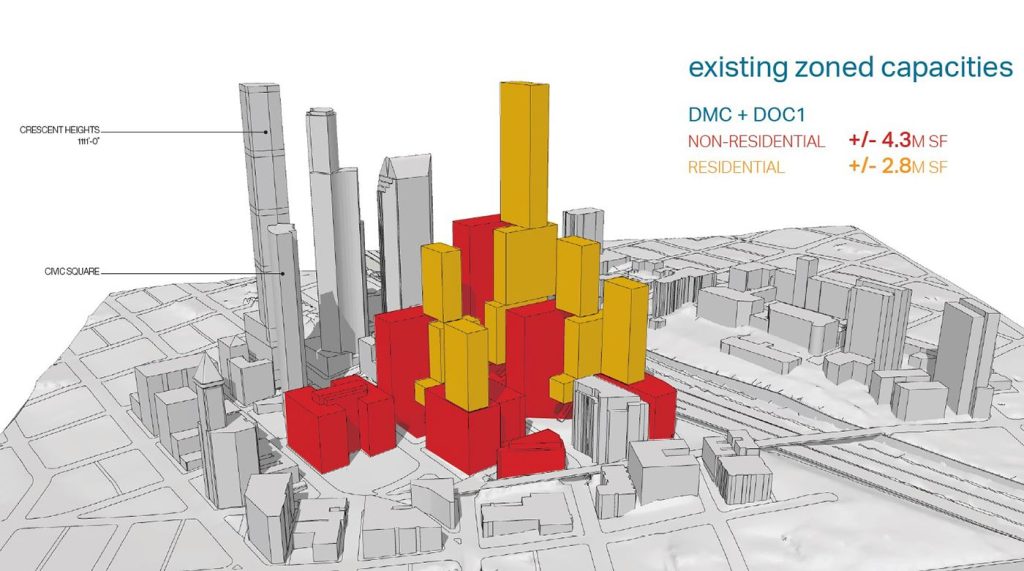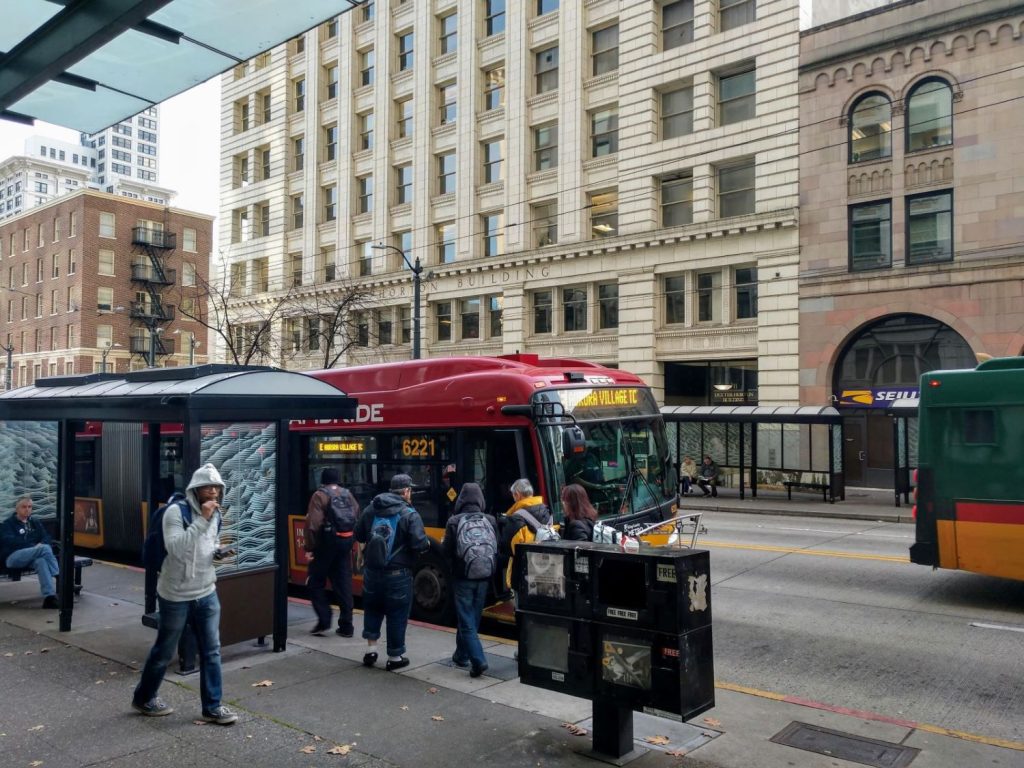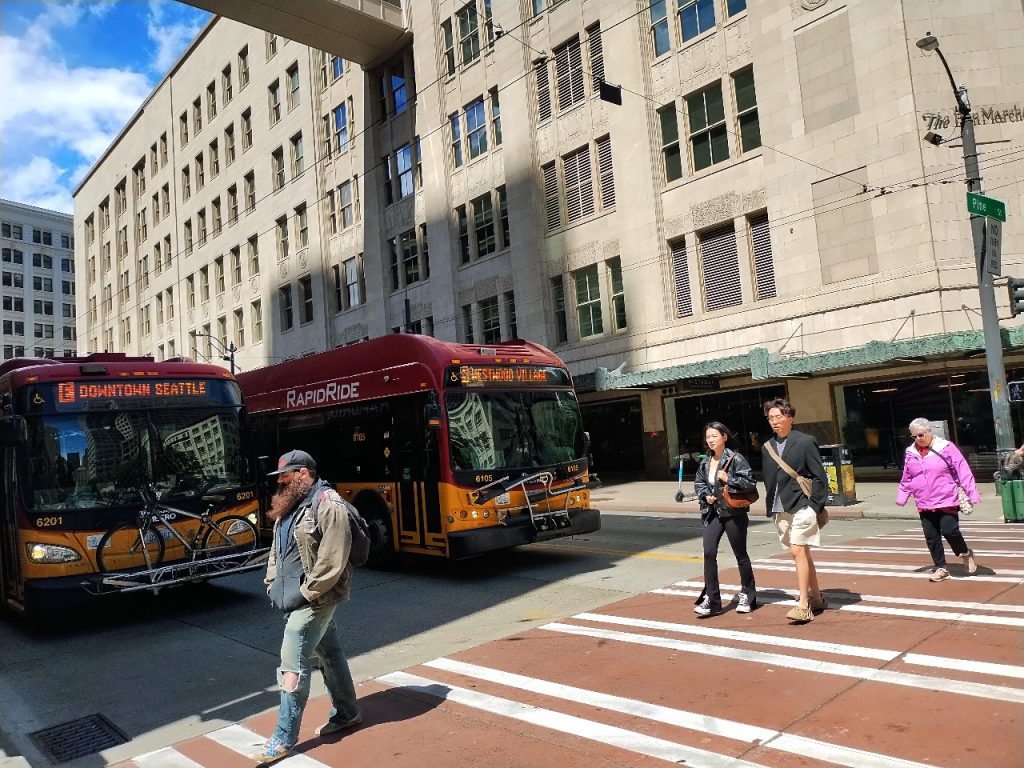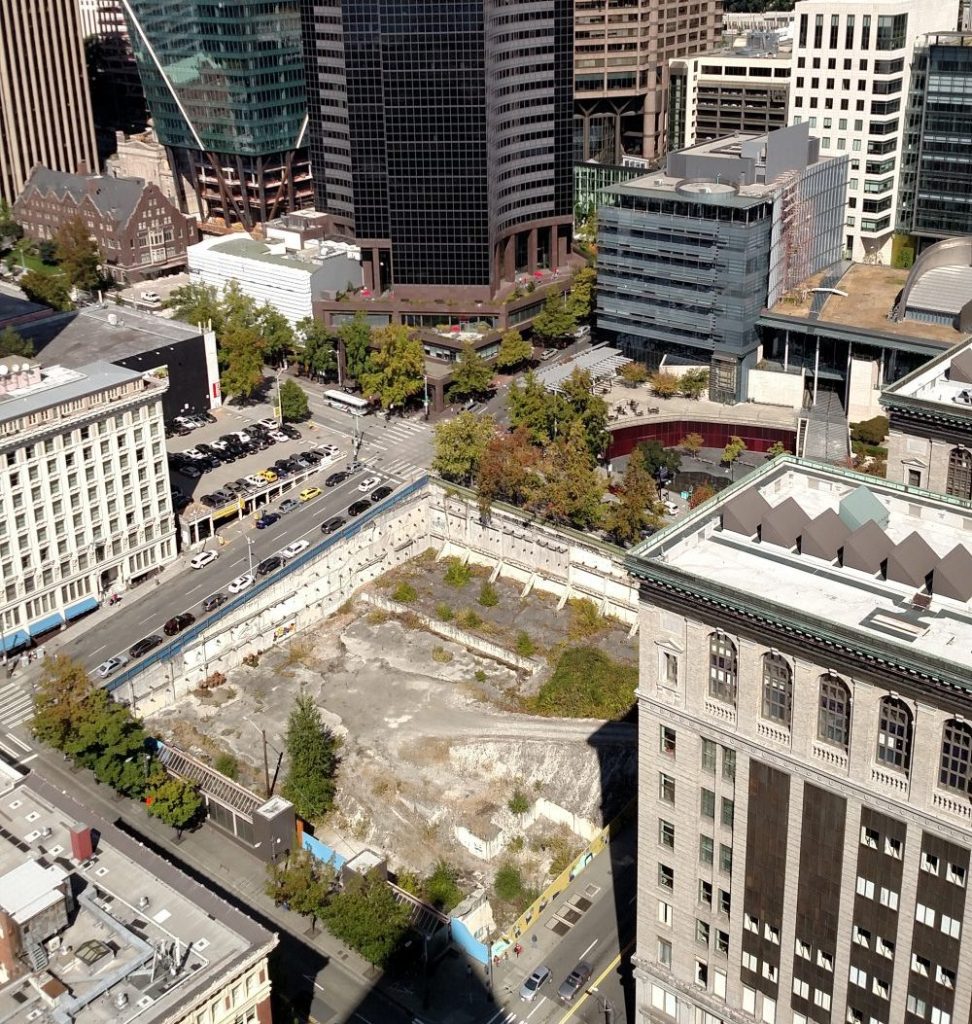
Mayor Bruce Harrell’s administration is touting gains made a year into the implementation of its highly-touted Downtown Activation Plan (DAP), intended to revitalize a central business district beset by office vacancies and somewhat lower foot traffic compared to pre-pandemic levels. While downtown has made positive gains, as more workers return to the office and events bring more people downtown, many of the long-term projects that the mayor’s plan had included haven’t made much progress.
For example, plans for the “Cultural Connector” streetcar extension stalled out and no visible progress made on piloting a long-promised “low-pollution neighborhood.”
At a press conference held last month, City leaders — including Deputy Mayor Tim Burgess, a member of the Seattle City Council from 2007 to 2017 — touted high-level statistics, including the fact that 93% of the DAP initiatives announced in 2023 have either been completed or are in progress. With visitor foot traffic back at 60% of what it was in 2019 and up 14% year-over-year, the city is celebrating progress as next year’s mayoral election approaches.
However, many of the biggest markers of a transformed Downtown Seattle that were promoted during the event are either projects that have been in the works for a long time, like the completion of the new Waterfront Park over a decade in the making, or have other government partners in the driver’s seat, like the potential full overhaul of King County’s downtown government campus.

Other progress is a bit aspirational rather than tangible. Burgess compared areas of downtown now to the South Lake Union area 20 years ago, suggesting that South Downtown was headed for a similar resurgence.
“In the mid 2000’s when I first joined the City Council, there was a very focused, intentional effort around South Lake Union, where the city government [and] the private sector were working together to remake that neighborhood, which was primarily made up of a bunch of abandoned buildings, warehouses. There wasn’t much going on there at all. And today we see what South Lake Union is: it’s lots of residential units, lots of offices, lots of people. It’s very successful neighborhood.”
This week, the Seattle City Council will consider a bill that would temporarily exempt new development downtown from design review, in an attempt to spur the construction of new housing, hotel, or laboratory space. That move follows successful rezones around Third Avenue that the Mayor proposed last year that have the aim of revitalizing some of downtown’s most intractable corners, and a bill making it easier for commercial property owners to convert their buildings into residential. But overall, many of the infrastructure projects planned in the DAP remain stuck in low gear, with the Harrell Administration’s own vision for the broader future of downtown still fairly unclear.

At the council meeting, City staff presented a map showing infrastructure projects in progress across downtown, with the waterfront redevelopment, streetscape improvements on Pike and Pine Streets, and the city’s longstanding plan to upgrade Third Avenue sticking out most prominently. Notably absent from the map was the $144 million RapidRide G project, set to open on September 14, bringing transit directly to First Avenue for the first time in years and providing six-minute bus service to downtown from First Hill, Capitol Hill, and the Central District.

Overall, transit got very little airtime during the meeting, apart from a discussion of planned upgrades to the Seattle Monorail, which the City apparently sees as essential to attracting an NBA team to Climate Pledge Arena. “We want to make sure that the monorail is capable both trains operating, generally restricted to one train today, but there’s huge opportunities here at Westlake Center to redo that monorail station, make it essentially the front porch to Seattle Center,” Burgess said.
The fate of the Cultural Connector Streetcar, which the Harrell Administration initially embraced as part of the DAP, remains up in the air, with Burgess telling reporters that “no final decision” has been made on the project, though the mayor opted against funding the project in the $1.55 billion transportation levy proposal that will go to voters in November. Early this year, a report pegged total costs to complete the project at $410 million, though that included some other needed infrastructure projects downtown, such as bolstering underground passageways in Pioneer Square. Given the obstacles, it would be easy for the Harrell Administration to abandon the streetcar project, but so far they haven’t officially done so.
When it comes to Third Avenue, where the Downtown Seattle Association has been working to advance options for a full-scale revamp of the street for several years. Jumpstarting those aspirations could hinge on Seattle voters approving the transportation levy this fall, which includes $15 million for broader downtown activation as well for “advancement of a longer-term vision for 3rd Ave.” In the meantime, Markham McIntyre, the Director of the Office of Economic Development, touted interim placemaking that the City has planned for the area of Third Avenue between Downtown and Belltown, and hinted at more announcements to come in advance of the 2026 FIFA World Cup.

“We know that as the world comes to Seattle, many folks are going to take transit from Sea-Tac, and their first impression of Seattle is going to be coming out on Third. It is our regional transit spine, and we’ve got to make some improvements there, especially at those multimodal intersections along Third,” McIntyre said. “We’re going to be doing a pilot block later this year where the old Bed Bath and Beyond building — where Cannonball Arts is now located — down to that Bergman Luggage, [which is] the Seattle Restored site. We’ve worked with the property owners along both sides, and we’ll make some great improvements to the physical environment, including hanging lighting across the street, projecting art onto the parking garage that’s on Third there, improving some of the planters and greenery and trees.”
Not mentioned was a plan to extend Third Avenue bus lanes further into Belltown, which the Seattle Department of Transportation (SDOT) has been planning to do, but which is on the cusp of being delayed, after Councilmember Bob Kettle raised questions about the project.
The City also hopes to activate another long-dormant spot — the infamous empty pit across from City Hall. With plans for developer Bosa to build a 58-story tower on the site still in limbo, the only hope is for near-term activation and placemaking. “We’re talking with the owners about what we could possibly put in there,” McIntyre said. “Longer term, we need to have something go into that space. And so we’re in discussions with the property owners about what that looks like.”
So far, the first year of the Downtown Activation Plan has been characterized more by plans for spot improvements rather than the transformative projects that would create the next South Lake Union. But with so many elements that have been in the works for years finally coming to fruition, epitomized by the completion of the waterfront, the Harrell Adminstration looks poised to ride that momentum for a while longer.
Ryan Packer has been writing for The Urbanist since 2015, and currently reports full-time as Contributing Editor. Their beats are transportation, land use, public space, traffic safety, and obscure community meetings. Packer has also reported for other regional outlets including BikePortland, Seattle Met, and PubliCola. They live in the Capitol Hill neighborhood of Seattle.


